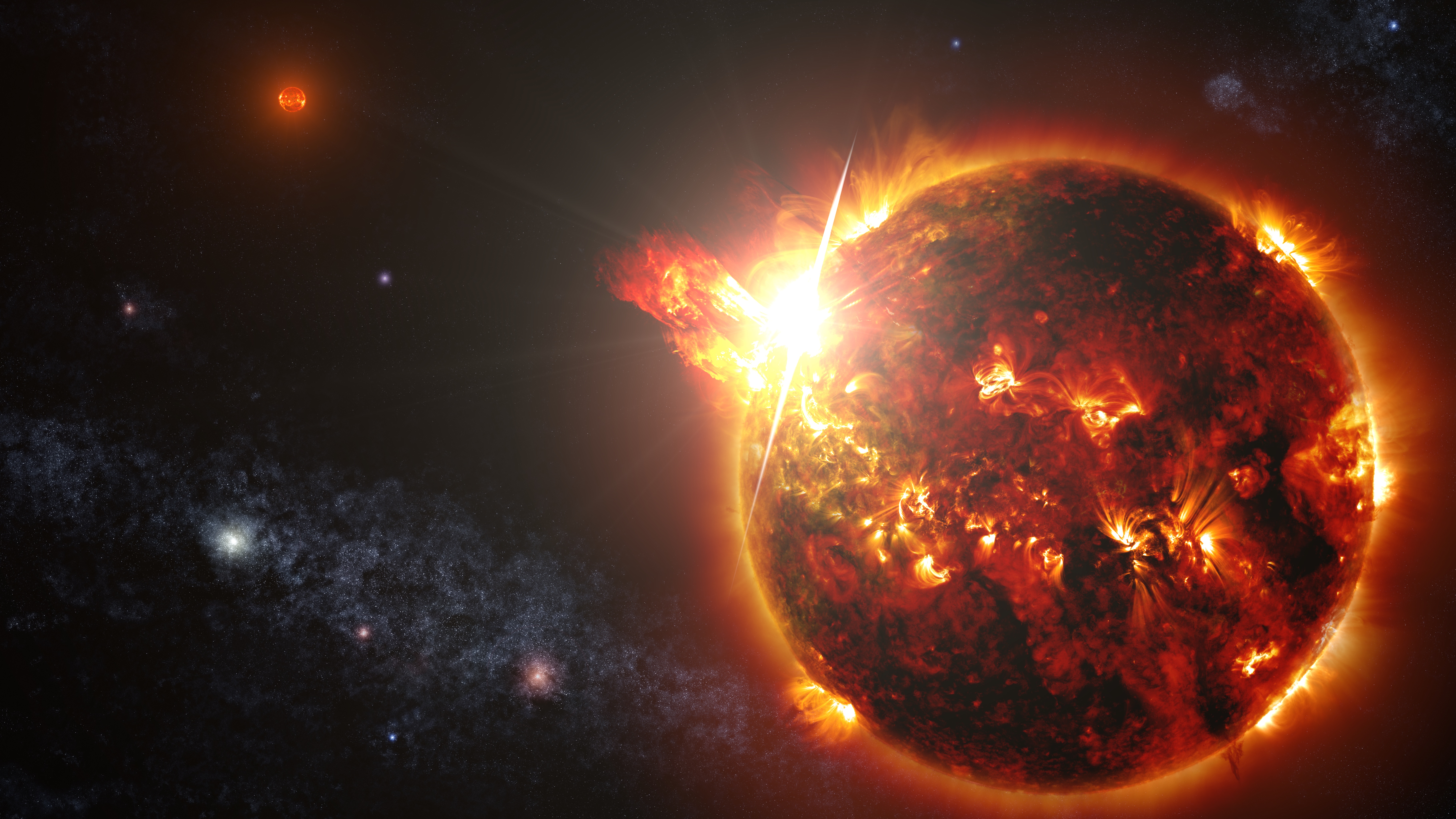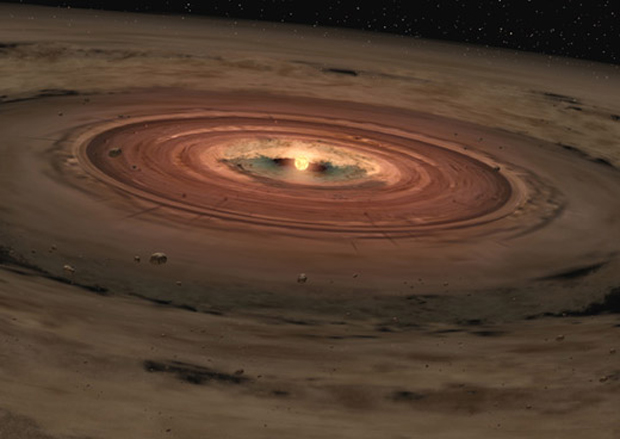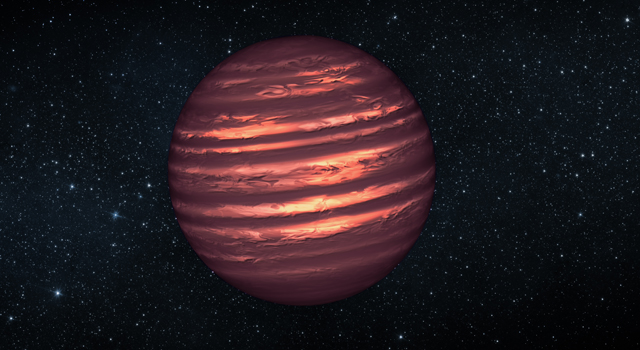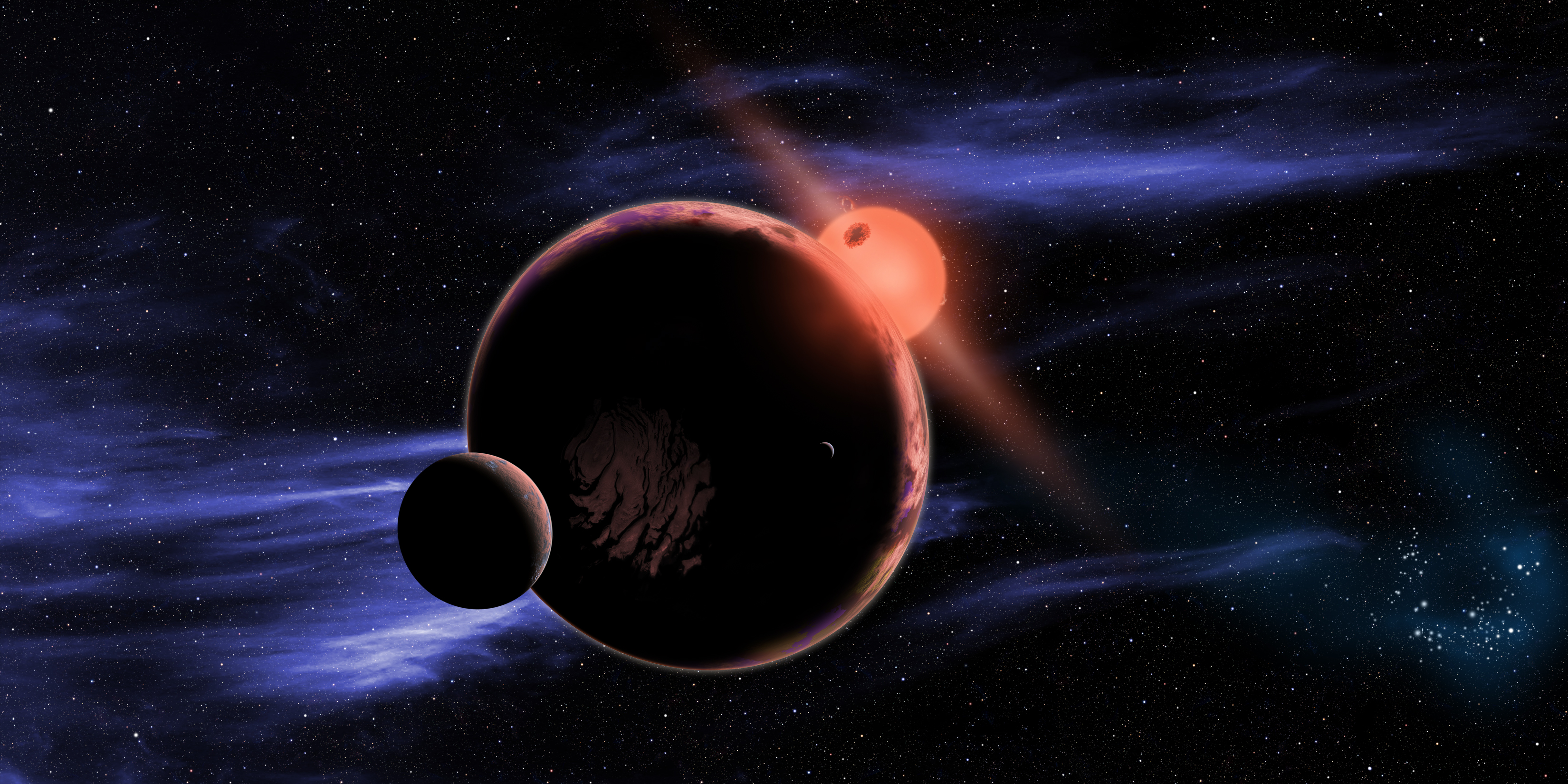Red Dwarfs: The Most Common and Longest-Lived Stars (original) (raw)

Artist's concept showing DG CVn — a binary system consisting of two red dwarf stars — unleashing a series of powerful flares seen by NASA's Swift spacecraft on April 23, 2014. (Image credit: NASA's Goddard Space Flight Center/S. Wiessinger)
Red dwarf stars make up the largest population of stars in the galaxy, but they hide in the shadows, too dim to be seen with the naked eye from Earth. Their limited radiance helps to extend their lifetimes, which are far greater than that of the sun.
Scientists think that 20 out of the 30 stars near Earth are red dwarfs. The closest star to the sun, Proxima Centauri, is a red dwarf.
The term "red dwarf" does not refer to a single kind of star. It is frequently applied to the coolest objects, including K and M dwarfs — which are true stars — and brown dwarfs, often referred to as "failed stars" because they do not sustain hydrogen fusion in their cores.
"There is no true definition of red dwarfs," astronomer Michaël Gillon of the University of Liège in Belgium told Space.com by email. Gillon, who studies stellar objects at the cooler end of the spectrum, was part of the team that identified the ultracool star TRAPPIST-1. Red dwarf "generally refers to dwarf stars with a spectral type ranging from K5V to M5V," Gillon said.
Formation and characteristics
Red dwarfs form like other main-sequence stars. First, a cloud of dust and gas is drawn together by gravity and begins rotating. The material then clumps at the center, and when it reaches the critical temperature, fusion begins.
Red dwarfs include the smallest of the stars, weighing between 7.5% and 50% the mass of the sun. Their reduced size means that they burn at a lower temperature, reaching only 6,380 degrees Fahrenheit (3,500 degrees Celsius). The sun, by comparison, has a temperature of 9,900 F (5,500 C). The low temperatures of red dwarfs mean they are far, far dimmer than stars like the sun.
Their low temperature also means that they burn through their supply of hydrogen less rapidly. While other, more massive stars burn through only the hydrogen at their core before coming to the end of their lifetimes, red dwarfs consume all of their hydrogen, inside and outside their core. This stretches out the lifetime of red dwarfs to trillions of years; far beyond the 10-billion-year lifetime of sun-like stars.

In this artist's conception, gas and dust swirl around a young star. Eventually this material should form planets through gravitational accretion. (Image credit: NASA/JPL-Caltech)
Classifying red dwarfs
Scientists occasionally have difficulty distinguishing a red dwarf star from a brown dwarf. Brown dwarfs are cool and dim, and likely form the same way red dwarfs do, but brown dwarfs never reach the point of fusion because they're too small, and therefore, they're not considered stars.
"When we observe a red dwarf and measure its atmosphere, we don't necessarily know whether it's a brown dwarf or a star — young brown dwarfs look almost exactly like ultracool stars," said Adam Burgasser, an astronomer at the University of California, San Diego.
To figure out whether a celestial object is a brown or red dwarf, scientists measure the temperature of the object's atmosphere. Fusion-free brown dwarfs are cooler than 2,000 Kelvin (3,140 F or 1,727 C), while hydrogen-fusing stars are warmer than 2,700 K (4,400 F or 2,427 C). In between, a star could be classified as a red dwarf or brown dwarf.
Sometimes, chemicals in the object's atmosphere can reveal clues about what's happening at its heart. According to Burgasser, the presence of molecules like methane or ammonia, which can only survive at cold temperatures, suggests that an object is a brown dwarf. Lithium in the atmosphere also suggests that a red dwarf is a brown dwarf rather than a true star.
But scientists may still use the term red dwarf to describe how a celestial object looks — small and dim — even if the object is actually a brown dwarf, Burgasser said.

Brown dwarfs mix features of stars and planets, but they are their own unique entities. This artist's illustration shows the brown dwarf 2MASSJ22282889-431026, which NASA's Spitzer and Hubble space telescopes simultaneously observed. (Image credit: NASA/JPL-Caltech)
A host of habitable planets?
Planets form from the material left over in a disk after their star has been created. Many red dwarfs have been found with planets surrounding them, though enormous gas giants are rare. Because red dwarfs are dimmer than stars like the sun, it is easier to find small planets that may surround these dimmer objects, making red dwarfs a popular target for planet hunting. NASA's Kepler space telescope (which operated between 2009 and 2018) and Transiting Exoplanet Survey Satellite, or TESS (which started operations in 2018), have surveyed many red dwarf stars for possible Earth-like planets.
Since the planets examined by TESS are near bright stars that tend to be close to Earth, it's easier for ground telescopes to follow up on the observations. In April 2019, TESS investigators announced they had found their mission's first Earth-size planet, although its conditions are not ideal for life as we know it.
For a long time, scientists thought red dwarfs were uninhabitable. Their limited light and heat meant that the habitable zone — or the region where liquid water could form on planets around a red dwarf — would be very close to the star, putting the planets in range of harmful radiation from the star. Other planets may be tidally locked to the star, with one side constantly facing the sun, causing one side to be too warm, and the other to be too cold.
In 2016, a potentially habitable planet was found orbiting Proxima Centauri (Earth's closest star). And in 2019, astronomers announced the possibility of a second planet orbiting far outside the star's habitable zone. At least seven Earth-size planets orbit the red dwarf TRAPPIST-1, and many studies suggest at least some of those planets could host life.

This artist’s conception shows a hypothetical habitable planet with two moons orbiting a red dwarf star. Astronomers have found that 6 percent of all red dwarf stars have an Earth-sized planet in the habitable zone, which is warm enough for liquid water on the planet’s surface. Since red dwarf stars are so common, then statistically the closest Earth-like planet should be only 13 light-years away. (Image credit: David A. Aguilar (CfA))
The end of the line
Tiny red dwarfs may have an extended lifetime, but like all other stars, they'll eventually burn through their supply of fuel. When they do, the red dwarfs become white dwarfs — dead stars that no longer undergo fusion at their core. Eventually, the white dwarfs will radiate away all of their heat and become black dwarfs.
But unlike the sun, which will become a white dwarf in a few billion years, red dwarfs will take trillions of years to burn through their fuel. This is significantly longer than the age of the universe, which is less than 14 billion years old. Red dwarfs may be a bit dim, but like the tortoise, they slowly but surely win the survival race.
Additional resources:
- Read the definition of a red dwarf according to Swinburne University.
- Find out why red dwarfs might be the best place to find alien life.
- Learn how superflares from red dwarfs endanger planets.
This article was updated on June 6, 2019 by Space.com contributor Elizabeth Howell.
Join our Space Forums to keep talking space on the latest missions, night sky and more! And if you have a news tip, correction or comment, let us know at: community@space.com.
Breaking space news, the latest updates on rocket launches, skywatching events and more!
Nola Taylor Tillman is a contributing writer for Space.com. She loves all things space and astronomy-related, and enjoys the opportunity to learn more. She has a Bachelor’s degree in English and Astrophysics from Agnes Scott college and served as an intern at Sky & Telescope magazine. In her free time, she homeschools her four children. Follow her on Twitter at @NolaTRedd